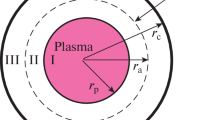Abstract
Depending on the angle θ between the wave vector and the magnetic field, helicons are conventionally divided into two branches: proper helicons (H mode), propagating at small θ, and Trivelpiece–Gould waves (TG mode), propagating at large θ. The latter are close to potential waves and have a significant electric component along the external magnetic field. It is believed that it is these waves that provide electron heating in helicon discharges. There is also commonly believed that current antennas, widely used to ignite helicon discharges, excite essentially nonpotential Н modes, which then transform into TG modes due to plasma inhomogeneity. In this work, it is demonstrated that electromagnetic energy can also be efficiently introduced in plasma by means of TG modes.
Similar content being viewed by others
References
F. F. Chen, Plasma Sources Sci. Technol. 24, 014001 (2015).
K. P. Shamrai and V. B. Taranov, Plasma Sources Sci. Technol. 5, 474 (1996).
V. F. Virko, G. S. Kirichenko, and K. P. Shamrai, Plasma Sources Sci. Technol. 11, 10 (2002).
K. P. Shamrai, Plasma Sources Sci. Technol. 7, 499 (1998).
D. Arnush, Phys. Plasmas 7, 3042 (2000).
G. R. Tynan, M. J. Burin, C. Holland, G. Antar, and N. Crocker, Phys. Plasmas 11, 5195 (2004).
R. W. Boswell, Plasma Phys. Controlled Fusion 26, 1147 (1984).
A. V. Timofeev, Plasma Phys. Rep. 41, 873 (2015).
S. Shinohara and T. Tanikawa, Phys. Plasmas 12, 044502 (2005).
A. G. Shalashov and E. D. Gospodchikov, Phys. Usp. 54, 145 (2011).
E. A. Bering, III, F. R. Chang-Diaz, I. P. Squire, V. Jacobson, L. D. Cassady, and M. Burkardt, in Proceedings of the 45th AIAA Aerospace Sciences Meeting and Exhibition, Reno, NV, 2007, Paper AIAA-2007-586.
X. M. Guo, J. Scharer, Y. Mouzouris, and L. Louis, Phys. Plasmas 6, 3400 (1999).
Author information
Authors and Affiliations
Corresponding author
Additional information
Original Russian Text © E.D. Gospodchikov, A.V. Timofeev, 2017, published in Fizika Plazmy, 2017, Vol. 43, No. 6, pp. 538–547.
Rights and permissions
About this article
Cite this article
Gospodchikov, E.D., Timofeev, A.V. Excitation of helicons by current antennas. Plasma Phys. Rep. 43, 638–647 (2017). https://doi.org/10.1134/S1063780X17060071
Received:
Revised:
Published:
Issue Date:
DOI: https://doi.org/10.1134/S1063780X17060071




